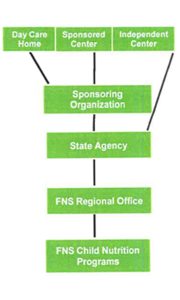
Illinois State Board of Education
Building for the Future in the
Child and Adult Care Food Program (CACFP)
How does CACFP work?
Day care homes and centers receive money for serving nutritious meals. The Food and Nutrition Service (FNS), an agency of the U.S. Department of Agriculture (USDA) oversees CACFP.
States approve sponsors and centers to operate the program. States also monitor and provide training and guidance to make sure CACFP runs right.
Sponsoring organizations support day care homes and centers with training and monitoring. All day care homes participate in CACFP through a sponsor.
CACFP Partners

Contacts
If you are interested in participating in CACFP or have questions about the Program, the Illinois State Board of Education, Nutrition Programs Division, can help. Please see our website (www.isbe.net/nutrition) for CACFP information or call 800/545-7892.
What is CACFP?
CACFP is the Child and Adult Care Food Program. It is a Federal program that pays for healthy meals and snacks for children and adults in day care.
CACFP improves the quality of day care. It makes the cost of day care cheaper for many low-income families.
Besides providing meals in day care, CACFP makes afterschool programs more appealing to at-risk children and youth. Serving afterschool meals and snacks attracts students to learning activities that are safe and fun.
Children and youth who are homeless can also receive meals at shelters that participate in CACFP.
Who is eligible for CACFP meals?
• Children under age 13,
• Migrant children under age 16,
• Children and youth under age 19 in afterschool programs in low-income areas,
• Children and youth under age 19 who live in homeless shelters, and
• Adults who are impaired or over age 60 and enrolled in adult day care
What kinds of meals are served?
CACFP meals follow USDA nutrition standards.
- Breakfast consists of milk, fruits or vegetables, and grains.
- Lunch and Supper require milk, grains, meat or other proteins, fruits, and vegetables.
- Snacks include two different servings from the five components: milk, fruits, vegetables, grains, or meat or other proteins.
Where are CACFP meals served?
Many types of facilities participate in CACFP.
Child Care Centers:
Licensed child care centers and Head Start programs provide day care with meals and snacks to large numbers of children.
Outside-School-Hours Care Centers:
Licensed centers offer before or afterschool care with meals and snacks to large numbers of school-aged children.
Family Day Care Homes:
Licensed providers offer family child care with free meals and snacks to small groups of children in private homes.
“At-Risk” Afterschool Care Programs:
Centers in low-income areas provide learning activities with free meals and snacks to school-age children and youth.
Emergency Shelters:
Homeless, domestic violence, and runaway youth shelters provide places to live with free meals for children and youth.
Adult Day Care Centers:
Licensed centers provide day care with meals and snacks to enrolled adults .
Name and Telephone Number of Organization:
The Association for Child Development
4415 Harrison St, Suite 535 Hillside, IL 60153, 1.800.284.5273
USDA FNS-319 October 2018
USDA is an equal opportunity provider, emplover and lender.